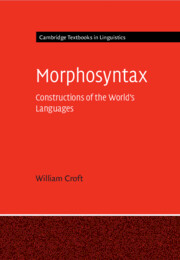Refine search
Actions for selected content:
6584 results in Grammar and Syntax
Part Four - Syntax-semantics, Pragmatics, and Discourse Issues
-
- Book:
- The Cambridge Handbook of Chinese Linguistics
- Published online:
- 04 August 2022
- Print publication:
- 18 August 2022, pp 405-706
-
- Chapter
- Export citation
Contributors
-
- Book:
- The Cambridge Handbook of Chinese Linguistics
- Published online:
- 04 August 2022
- Print publication:
- 18 August 2022, pp xiii-xiv
-
- Chapter
- Export citation
3 - Wordhood and Disyllabicity in Chinese
- from Part Two - Morpho-lexical Issues in Chinese
-
-
- Book:
- The Cambridge Handbook of Chinese Linguistics
- Published online:
- 04 August 2022
- Print publication:
- 18 August 2022, pp 47-73
-
- Chapter
- Export citation
6 - Gaps in Parts of Speech in Chinese and Why?
- from Part Two - Morpho-lexical Issues in Chinese
-
-
- Book:
- The Cambridge Handbook of Chinese Linguistics
- Published online:
- 04 August 2022
- Print publication:
- 18 August 2022, pp 114-134
-
- Chapter
- Export citation
27 - Sentence-final Particles
- from Part Four - Syntax-semantics, Pragmatics, and Discourse Issues
-
-
- Book:
- The Cambridge Handbook of Chinese Linguistics
- Published online:
- 04 August 2022
- Print publication:
- 18 August 2022, pp 597-615
-
- Chapter
- Export citation
12 - Mandarin Chinese Syllable Structure and Phonological Similarity
- from Part Three - Phonetic-phonological Issues in Chinese
-
-
- Book:
- The Cambridge Handbook of Chinese Linguistics
- Published online:
- 04 August 2022
- Print publication:
- 18 August 2022, pp 245-274
-
- Chapter
- Export citation
26 - Syntax of Sentence-final Particles in Chinese
- from Part Four - Syntax-semantics, Pragmatics, and Discourse Issues
-
-
- Book:
- The Cambridge Handbook of Chinese Linguistics
- Published online:
- 04 August 2022
- Print publication:
- 18 August 2022, pp 578-596
-
- Chapter
- Export citation
16 - Tone and Intonation
- from Part Three - Phonetic-phonological Issues in Chinese
-
-
- Book:
- The Cambridge Handbook of Chinese Linguistics
- Published online:
- 04 August 2022
- Print publication:
- 18 August 2022, pp 336-360
-
- Chapter
- Export citation

The Cambridge Handbook of Chinese Linguistics
-
- Published online:
- 04 August 2022
- Print publication:
- 18 August 2022

Morphosyntax
- Constructions of the World's Languages
-
- Published online:
- 04 August 2022
- Print publication:
- 04 August 2022
-
- Textbook
- Export citation
Language Index
-
- Book:
- Morphosyntax
- Published online:
- 04 August 2022
- Print publication:
- 04 August 2022, pp 755-760
-
- Chapter
- Export citation
5 - The Structure and Origin of Modification Constructions
- from Part II - Argument Phrase Structure
-
- Book:
- Morphosyntax
- Published online:
- 04 August 2022
- Print publication:
- 04 August 2022, pp 140-168
-
- Chapter
- Export citation
2 - Propositional Act Constructions
- from Part I - Introduction
-
- Book:
- Morphosyntax
- Published online:
- 04 August 2022
- Print publication:
- 04 August 2022, pp 32-62
-
- Chapter
- Export citation
Part IV - Complex Sentences
-
- Book:
- Morphosyntax
- Published online:
- 04 August 2022
- Print publication:
- 04 August 2022, pp 459-615
-
- Chapter
- Export citation
4 - Modification
- from Part II - Argument Phrase Structure
-
- Book:
- Morphosyntax
- Published online:
- 04 August 2022
- Print publication:
- 04 August 2022, pp 103-139
-
- Chapter
- Export citation
15 - Temporal and Causal Relations between Events
- from Part IV - Complex Sentences
-
- Book:
- Morphosyntax
- Published online:
- 04 August 2022
- Print publication:
- 04 August 2022, pp 461-492
-
- Chapter
- Export citation
Author Index
-
- Book:
- Morphosyntax
- Published online:
- 04 August 2022
- Print publication:
- 04 August 2022, pp 747-754
-
- Chapter
- Export citation
Abbreviations
-
- Book:
- Morphosyntax
- Published online:
- 04 August 2022
- Print publication:
- 04 August 2022, pp xxxiii-xxxvi
-
- Chapter
- Export citation
16 - Reference Tracking in Coordinate and Adverbial Clause Constructions
- from Part IV - Complex Sentences
-
- Book:
- Morphosyntax
- Published online:
- 04 August 2022
- Print publication:
- 04 August 2022, pp 493-512
-
- Chapter
- Export citation
13 - Eventive Complex Predicates and Related Constructions
- from Part III - Clause Structure
-
- Book:
- Morphosyntax
- Published online:
- 04 August 2022
- Print publication:
- 04 August 2022, pp 397-431
-
- Chapter
- Export citation
